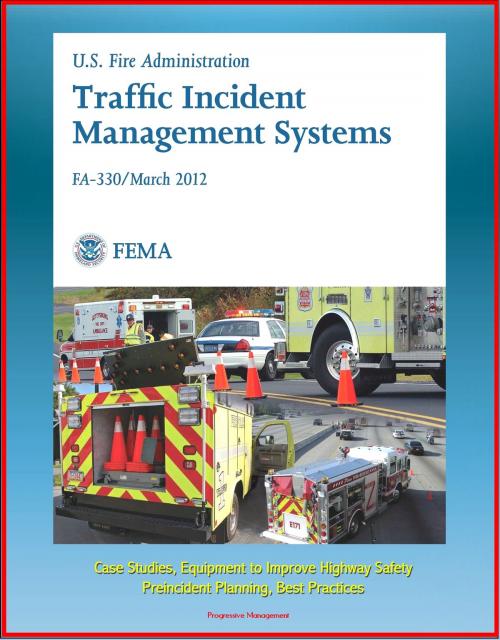FEMA U.S. Fire Administration Traffic Incident Management Systems (FA-330) - Case Studies, Equipment to Improve Highway Safety, Preincident Planning, Best Practices
Nonfiction, Health & Well Being, Medical, Allied Health Services, Emergency Medical Services, Science & Nature, Technology, Engineering, Civil| Author: | Progressive Management | ISBN: | 9781476030661 |
| Publisher: | Progressive Management | Publication: | August 17, 2012 |
| Imprint: | Smashwords Edition | Language: | English |
| Author: | Progressive Management |
| ISBN: | 9781476030661 |
| Publisher: | Progressive Management |
| Publication: | August 17, 2012 |
| Imprint: | Smashwords Edition |
| Language: | English |
In 2003, the U.S. Fire Administration (USFA) announced a goal to reduce firefighter fatalities by 25 percent within 5 years and 50 percent within 10 years. It also committed to doing research that would support that goal. The consistently high annual percentage of fatalities related to fire department response and roadway scene operations prompted the USFA to look at several aspects related to these collisions in an effort to improve responder safety.
Firefighters who are killed in privately owned vehicles (POVs) during the course of their duties account for the largest percentage of vehicle-related deaths. These are typically volunteer firefighters who are responding to or returning from emergency calls. However, career firefighters are also occasionally killed in POVs while performing their duties.
Contents: Preface * Chapter 1 * Introduction * Other Government Initiatives for Roadway Safety * Federal Highway Administration Traffic Incident Management Website * Federal Highway Administration Traffic Incident Management Handbook * National Traffic Incident Management Coalition * Data Collection * Firefighter Fatalities * Firefighter Injuries * Secondary Collisions * Factors Influencing the Occurrence of Roadway Scene Incidents * Other Considerations Relative to Roadway Incident Scenes * Economic Impact * Impact of Travel Delay Resulting From Vehicle Collisions * Project Goals * Manual of Uniform Traffic Control Devices for Streets and Highways * Chapter 2 * Incident Case Studies * Case Study 1 * Case Study 2 * Case Study 3 * Case Study 4 * Case Study 5 * Case Study 6 * Case Study 7 * Case Study 8 * Case Study 9 * Case Study 10 * Case Study 11 * Case Study 12 * Case Study 13 * Case Study 14 * Summary * Chapter 3 * Equipment to Improve Highway Safety * Intelligent Transportation Systems Technologies to Improve Roadway Safety * Traffic Surveillance Technology * Mayday and Automatic Collision Notification Systems * Freeway Service Patrols * Changeable Message Signs * Temporary Traffic Control Zones * Channelizing Devices * Signs * Cones * Flares * Directional Arrow Boards * Barricades * Flagger Control * Hand-Signaling Devices * Flagger Location * Audible Warning Signals * High-Visibility Safety Apparel * American National Standards Institute/International Safety Equipment Association 107 * Fabric * Fluorescence * Retroreflectivity * American National Standards Institute/International Safety Equipment Association 207 * Fire Apparatus Safety Equipment * Restraints * Vehicle Striping * Warning Lights * European Concepts in Roadway Scene Equipment and Practices * Recommendations for Roadway Safety Equipment * Chapter 4 * Setting Up Safe Traffic Incident Management Areas * Establishing the Work Area * Emergency Vehicle Placement * Emergency-Vehicle Warning Lights Exiting the Apparatus * Determining the Magnitude of the Incident * Minor Incident * Intermediate and Major Incidents * Expanding the Work Area * Flaggers * Terminating the Temporary Traffic Control Operation * Recommendations for Setting Up a Safe Work Zone * Chapter 5 * Preincident Planning and Incident Command for Roadway Incidents * Preincident Planning for Roadway Incidents * Sharing Information * Developing the Preincident Plan * Managing Roadway Incidents * Initiating Incident Management * Commanding The Incident * Transportation Department Roles in the Highway Incident ICS Organization * Organizing the Incident * Prior to Arrival of Response Units * Small Response * Expanded Incident * Reinforced Response * Additional Considerations * Recommendations for Managing Highway Incidents * Chapter 6 * Best Practices and Other Sources of Information for Effective Highway Incident Operations
In 2003, the U.S. Fire Administration (USFA) announced a goal to reduce firefighter fatalities by 25 percent within 5 years and 50 percent within 10 years. It also committed to doing research that would support that goal. The consistently high annual percentage of fatalities related to fire department response and roadway scene operations prompted the USFA to look at several aspects related to these collisions in an effort to improve responder safety.
Firefighters who are killed in privately owned vehicles (POVs) during the course of their duties account for the largest percentage of vehicle-related deaths. These are typically volunteer firefighters who are responding to or returning from emergency calls. However, career firefighters are also occasionally killed in POVs while performing their duties.
Contents: Preface * Chapter 1 * Introduction * Other Government Initiatives for Roadway Safety * Federal Highway Administration Traffic Incident Management Website * Federal Highway Administration Traffic Incident Management Handbook * National Traffic Incident Management Coalition * Data Collection * Firefighter Fatalities * Firefighter Injuries * Secondary Collisions * Factors Influencing the Occurrence of Roadway Scene Incidents * Other Considerations Relative to Roadway Incident Scenes * Economic Impact * Impact of Travel Delay Resulting From Vehicle Collisions * Project Goals * Manual of Uniform Traffic Control Devices for Streets and Highways * Chapter 2 * Incident Case Studies * Case Study 1 * Case Study 2 * Case Study 3 * Case Study 4 * Case Study 5 * Case Study 6 * Case Study 7 * Case Study 8 * Case Study 9 * Case Study 10 * Case Study 11 * Case Study 12 * Case Study 13 * Case Study 14 * Summary * Chapter 3 * Equipment to Improve Highway Safety * Intelligent Transportation Systems Technologies to Improve Roadway Safety * Traffic Surveillance Technology * Mayday and Automatic Collision Notification Systems * Freeway Service Patrols * Changeable Message Signs * Temporary Traffic Control Zones * Channelizing Devices * Signs * Cones * Flares * Directional Arrow Boards * Barricades * Flagger Control * Hand-Signaling Devices * Flagger Location * Audible Warning Signals * High-Visibility Safety Apparel * American National Standards Institute/International Safety Equipment Association 107 * Fabric * Fluorescence * Retroreflectivity * American National Standards Institute/International Safety Equipment Association 207 * Fire Apparatus Safety Equipment * Restraints * Vehicle Striping * Warning Lights * European Concepts in Roadway Scene Equipment and Practices * Recommendations for Roadway Safety Equipment * Chapter 4 * Setting Up Safe Traffic Incident Management Areas * Establishing the Work Area * Emergency Vehicle Placement * Emergency-Vehicle Warning Lights Exiting the Apparatus * Determining the Magnitude of the Incident * Minor Incident * Intermediate and Major Incidents * Expanding the Work Area * Flaggers * Terminating the Temporary Traffic Control Operation * Recommendations for Setting Up a Safe Work Zone * Chapter 5 * Preincident Planning and Incident Command for Roadway Incidents * Preincident Planning for Roadway Incidents * Sharing Information * Developing the Preincident Plan * Managing Roadway Incidents * Initiating Incident Management * Commanding The Incident * Transportation Department Roles in the Highway Incident ICS Organization * Organizing the Incident * Prior to Arrival of Response Units * Small Response * Expanded Incident * Reinforced Response * Additional Considerations * Recommendations for Managing Highway Incidents * Chapter 6 * Best Practices and Other Sources of Information for Effective Highway Incident Operations















